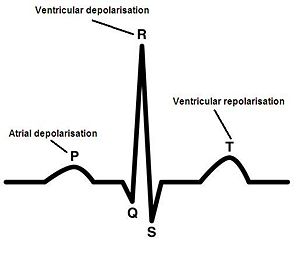ECG: Difference between revisions
Kingrajinix (talk | contribs) |
Kingrajinix (talk | contribs) |
||
| Line 21: | Line 21: | ||
To assess '''rhythm''', look at the rhythm strip (the long one at the bottom). Grab a piece of paper, aligning the edge with the rhythm strip. Mark on the edge where each QRS complex is. Move the piece of paper along. If the rhythm is regular, the markings on the edge of the paper will align with QRS complexes further down the rhythm strip. If they don't, the rhythm is irregular. | To assess '''rhythm''', look at the rhythm strip (the long one at the bottom). Grab a piece of paper, aligning the edge with the rhythm strip. Mark on the edge where each QRS complex is. Move the piece of paper along. If the rhythm is regular, the markings on the edge of the paper will align with QRS complexes further down the rhythm strip. If they don't, the rhythm is irregular. | ||
===Axis=== | |||
[[image:axisdeviation|right|thumb|350px|If you learn nothing else about axis deviation, learn this diagram]] | |||
There are lots of clever explanations in the understanding of axis devation. You will get none of those here (though check out [[ECG physics]] for a better explanation). | |||
Revision as of 09:55, 6 April 2010
An ECG or electrocardiogram is a way of evaluating the electrical activity of the heart. It is regularly used and can detect many heart abnormalities at the bedside. However, it takes time to learn how to interpret in and a systematic approach is helpful. ECG physics is more complicated and is on a seperate page.
Basics
If you want more detail than this, see ECG physics but this is what you can probably get away with in terms of physiology. The ECG is split into big boxes, each made of 5x5 little boxes. Each little box is 1mm (big box is 5mm). Going across the page, you have time, down the page you electrical activity. In terms of time:
- 1 little box (1mm) - 0.04ms
- 1 big box (5mm) - 0.2s
In terms of electrical activity:
- 1 little box (1mm) - 0.1mV
- 1 big box (5mm) - 0.5mV
These numbers come in useful later. Essentially, the normal ECG looks like this:

As you can see each little peak and trough is given. The only ones that aren't labelled are the Q and S waves. Q waves are not always present depend on which ECG lead you look at (it is complicated but in simple terms, it is the beginning of ventricular depolarisation). S waves occur at the end of ventricular depolarisation - essentially the electrical activity goes a little past zero on its ways down, before going back up.
Interpretation
Rate and rhythm
Rate is relatively easy to measure. As long as the rhythm is regular, you can simply divide the number of big boxes between each QRS complex by 300. The distance between each QRS is often referred to as the RR interval. So:
To assess rhythm, look at the rhythm strip (the long one at the bottom). Grab a piece of paper, aligning the edge with the rhythm strip. Mark on the edge where each QRS complex is. Move the piece of paper along. If the rhythm is regular, the markings on the edge of the paper will align with QRS complexes further down the rhythm strip. If they don't, the rhythm is irregular.
Axis
There are lots of clever explanations in the understanding of axis devation. You will get none of those here (though check out ECG physics for a better explanation).
